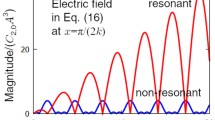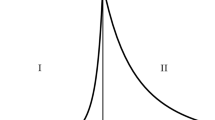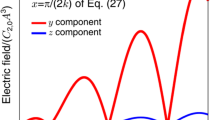Abstract
The vacuum is expected to exhibit electromagnetic nonlinearity via virtual electron–positron pairs. An electromagnetic wave is modulated. The self-modulation has been believed to be vanishingly small. However, a large self-modulation can appear in a long timescale, even though the intensity of electromagnetic wave is not extremely strong. To demonstrate this assertion, we theoretically consider standing electromagnetic waves with modest intensity confined in a two-dimensional rectangular cavity. We first calculate in a short timescale by applying a perturbative linear approximation. We show a secular term. Then, beyond the linear approximation, we derive differential equations for slowly varying amplitude and phase in a long timescale. A large self-modulation of polarization, phase, and energy ratio of each mode are obtained by solving the equations. In particular, the energy ratio is classified into three types. Namely, it keeps oscillating, eventually converges, or stays constant.
Graphical Abstract






Similar content being viewed by others
Data Availability Statement
This manuscript has no associated data, or the data will not be deposited. [Authors’ comment: The datasets generated during the current study are available from the corresponding author on reasonable request.]
References
W. Heisenberg, H. Euler, Folgerungen aus der Diracschen theorie des positrons. Z. Phys. 98(11), 714–732 (1936). https://doi.org/10.1007/BF01343663
J. Schwinger, On gauge invariance and vacuum polarization. Phys. Rev. 82, 664–679 (1951). https://doi.org/10.1103/PhysRev.82.664
M. Born, L. Infeld, R.H. Fowler, Foundations of the new field theory. Proc. R. Soc Lond. Ser. A Contain. Pap. Math. Phys. Charact. 144(852), 425–451 (1934). https://doi.org/10.1098/rspa.1934.0059
E.H. Wichmann, N.M. Kroll, Vacuum polarization in a strong coulomb field. Phys. Rev. 101, 843–859 (1956). https://doi.org/10.1103/PhysRev.101.843
V.I. Denisov, N.V. Kravtsov, I.V. Krivchenkov, A nonlinear electrodynamical shift of spectral lines in the hydrogen atom and hydrogen-like ions. Opt. Spectrosc. 100(5), 641–644 (2006). https://doi.org/10.1134/S0030400X06050018
H. Carley, M.K.-H. Kiessling, Nonperturbative calculation of Born–Infeld effects on the schrödinger spectrum of the hydrogen atom. Phys. Rev. Lett. 96, 030402 (2006). https://doi.org/10.1103/PhysRevLett.96.030402
S.H. Mazharimousavi, M. Halilsoy, Ground state h-atom in Born–Infeld theory. Found. Phys. 42(4), 524–530 (2012). https://doi.org/10.1007/s10701-011-9623-7
P.N. Akmansoy, L.G. Medeiros, Constraining Born–Infeld-like nonlinear electrodynamics using hydrogen’s ionization energy. Eur. Phys. J. C 78(2), 143 (2018). https://doi.org/10.1140/epjc/s10052-018-5643-1
I.C.E. TURCU, F. Negoita, D. Jaroszynski, P. Mckenna, S. Balascuta, D. Ursescu, I. Dancus, M. Cernaianu, M.V. TATARU, P. Ghenuche, D. STUTMAN, A. BOIANU, M. RISCA, M. Toma, C. PETCU, G. ACBAS, S. Yoffe, A. Noble, B. Ersfeld, N. Zamfir, High field physics and QED experiments at ELI-NP. Roman. Rep. Phys. 68, 145 (2016)
A. Di Piazza, C. Müller, K.Z. Hatsagortsyan, C.H. Keitel, Extremely high-intensity laser interactions with fundamental quantum systems. Rev. Mod. Phys. 84, 1177–1228 (2012). https://doi.org/10.1103/RevModPhys.84.1177
B. King, T. Heinzl, Measuring vacuum polarization with high-power lasers. High Power Laser Sci. Eng. 4, 5 (2016). https://doi.org/10.1017/hpl.2016.1
G.A. Mourou, T. Tajima, S.V. Bulanov, Optics in the relativistic regime. Rev. Mod. Phys. 78, 309–371 (2006). https://doi.org/10.1103/RevModPhys.78.309
D. Eriksson, G. Brodin, M. Marklund, L. Stenflo, Possibility to measure elastic photon-photon scattering in vacuum. Phys. Rev. A 70, 013808 (2004). https://doi.org/10.1103/PhysRevA.70.013808
G. Brodin, M. Marklund, L. Stenflo, Proposal for detection of QED vacuum nonlinearities in Maxwell’s equations by the use of waveguides. Phys. Rev. Lett. 87, 171801 (2001). https://doi.org/10.1103/PhysRevLett.87.171801
S.N. Vlasov, Nonlinear self-similar beams of electromagnetic waves in vacuum. Radiophys. Quantum Electron. 58(7), 497–503 (2015). https://doi.org/10.1007/s11141-015-9622-1
A. Arza, R.G. Elias, Parametric resonance in quantum electrodynamics vacuum birefringence. Phys. Rev. D 97, 096005 (2018). https://doi.org/10.1103/PhysRevD.97.096005
G.L.J.A. Rikken, C. Rizzo, Magnetoelectric birefringences of the quantum vacuum. Phys. Rev. A 63, 012107 (2000). https://doi.org/10.1103/PhysRevA.63.012107
K. Shibata, Intrinsic resonant enhancement of light by nonlinear vacuum. Eur. Phys. J. D 74(10), 215 (2020). https://doi.org/10.1140/epjd/e2020-10420-1
K. Shibata, Electromagnetic resonance of nonlinear vacuum in one-dimensional cavity. Eur. Phys. J. D 75(6), 169 (2021). https://doi.org/10.1140/epjd/s10053-021-00181-w
G. Brodin, M. Marklund, L. Stenflo, Influence of QED vacuum nonlinearities on waveguide modes. Phys. Scr. T98(1), 127 (2001). https://doi.org/10.1238/physica.topical.098a00127
R. Ferraro, Testing Born–Infeld electrodynamics in waveguides. Phys. Rev. Lett. 99, 230401 (2007). https://doi.org/10.1103/PhysRevLett.99.230401
V.I. Denisov, I.P. Denisova, Verifiable post-Maxwellian effect of the nonlinear electrodynamics in vacuum. Opt. Spectrosc. 90(2), 282–287 (2001). https://doi.org/10.1134/1.1351588
F. Della Valle, E. Milotti, A. Ejlli, G. Messineo, L. Piemontese, G. Zavattini, U. Gastaldi, R. Pengo, G. Ruoso, First results from the new PVLAS apparatus: a new limit on vacuum magnetic birefringence. Phys. Rev. D 90, 092003 (2014). https://doi.org/10.1103/PhysRevD.90.092003
F.D. Valle, G.D. Domenico, U. Gastaldi, E. Milotti, R. Pengo, G. Ruoso, G. Zavattini, Towards a direct measurement of vacuum magnetic birefringence: PVLAS achievements. Optics Commun. 283(21), 4194–4198 (2010). https://doi.org/10.1016/j.optcom.2010.06.065
G. Zavattini, F.D. Valle, U. Gastaldi, G. Messineo, E. Milotti, R. Pengo, L. Piemontese, G. Ruoso, The PVLAS experiment: detecting vacuum magnetic birefringence. J. Phys.: Conf. Ser. 442, 012057 (2013). https://doi.org/10.1088/1742-6596/442/1/012057
M. Bregant, G. Cantatore, S. Carusotto, R. Cimino, F. Della Valle, G. Di Domenico, U. Gastaldi, M. Karuza, V. Lozza, E. Milotti, E. Polacco, G. Raiteri, G. Ruoso, E. Zavattini, G. Zavattini, Limits on low energy photon-photon scattering from an experiment on magnetic vacuum birefringence. Phys. Rev. D 78, 032006 (2008). https://doi.org/10.1103/PhysRevD.78.032006
F. Della Valle, A. Ejlli, U. Gastaldi, G. Messineo, E. Milotti, R. Pengo, G. Ruoso, G. Zavattini, The PVLAS experiment: measuring vacuum magnetic birefringence and dichroism with a birefringent Fabry–Perot cavity. Eur. Phys. J. C 76(1), 24 (2016). https://doi.org/10.1140/epjc/s10052-015-3869-8
A. Cadène, P. Berceau, M. Fouché, R. Battesti, C. Rizzo, Vacuum magnetic linear birefringence using pulsed fields: status of the BMV experiment. Eur. Phys. J. D 68(1), 16 (2014). https://doi.org/10.1140/epjd/e2013-40725-9
X. Fan, S. Kamioka, T. Inada, T. Yamazaki, T. Namba, S. Asai, J. Omachi, K. Yoshioka, M. Kuwata-Gonokami, A. Matsuo, K. Kawaguchi, K. Kindo, H. Nojiri, The oval experiment: a new experiment to measure vacuum magnetic birefringence using high repetition pulsed magnets. Eur. Phys. J. D 71(11), 308 (2017). https://doi.org/10.1140/epjd/e2017-80290-7
K. Shibata, Long-time behavior of a nonlinear elecromagnetic wave in vacuum beyond the linear approximation. Phys. Rev. A 104, 063513 (2021). https://doi.org/10.1103/PhysRevA.104.063513
J. Plebanski, Lectures on Non-linear Electrodynamics: an Extended Version of Lectures Given at the Niels Bohr Institute and NORDITA, Copenhagen, in October 1968. Copenhagen: NORDITA (1970). https://www.osti.gov/servlets/purl/4071071
M. Fouché, R. Battesti, C. Rizzo, Limits on nonlinear electrodynamics. Phys. Rev. D 93, 093020 (2016). https://doi.org/10.1103/PhysRevD.93.093020
R. Baier, A. Rebhan, M. Wödlinger, Light-by-light scattering in the presence of magnetic fields. Phys. Rev. D 98, 056001 (2018). https://doi.org/10.1103/PhysRevD.98.056001
K. Shibata, Incompatible case of perfect conductor approximation in vacuum nonlinear electromagnetism. Phys. Scr. 97(2), 025506 (2022). https://doi.org/10.1088/1402-4896/ac4c54
H. Katori, V.D. Ovsiannikov, S.I. Marmo, V.G. Palchikov, Strategies for reducing the light shift in atomic clocks. Phys. Rev. A 91, 052503 (2015). https://doi.org/10.1103/PhysRevA.91.052503
J.H. Durrell, A.R. Dennis, J. Jaroszynski, M.D. Ainslie, K.G.B. Palmer, Y.-H. Shi, A.M. Campbell, J. Hull, M. Strasik, E.E. Hellstrom, D.A. Cardwell, A trapped field of 17.6 t in melt-processed, bulk Gd-Ba-Cu-O reinforced with shrink-fit steel. Supercond. Sci. Technol. 27(8), 082001 (2014). https://doi.org/10.1088/0953-2048/27/8/082001
E. Lundström, G. Brodin, J. Lundin, M. Marklund, R. Bingham, J. Collier, J.T. Mendonça, P. Norreys, Using high-power lasers for detection of elastic photon-photon scattering. Phys. Rev. Lett. 96, 083602 (2006). https://doi.org/10.1103/PhysRevLett.96.083602
I. Kopchinskii, P. Satunin, Resonant generation of electromagnetic modes in nonlinear electrodynamics: classical approach. Phys. Rev. A 105, 013508 (2022). https://doi.org/10.1103/PhysRevA.105.013508
Acknowledgements
The author thanks Dr. M. Nakai and Dr. K. Mima for discussions on the nonlinear electromagnetic wave and its experimental application. The author quite appreciates Dr. J. Gabayno for checking the logical consistency of the text.
Author information
Authors and Affiliations
Contributions
The whole work was done only by the author.
Corresponding author
Ethics declarations
Conflict of interest
The author declares that there is no conflict of interest.
Appendices
Appendix A: The function \({\mathcal {S}}\) appearing in Eq.(33)
In this “Appendix A,” any symbols are not related to physical meanings referred to in the main text.
Let y be an analytic function of x, we solve the following equation
with the initial values of \(y(0)=0\) and \(y'(0)=1\). The constants \(\lambda _1\) and \(\lambda _2\) are determined such that the second parentheses in the right-hand side does not have a root in \([-1,1]\). Such a region V is given by
By defining a unique \(\varphi \) for each x by
the unique solution \(y(x)={\mathcal {S}}(x; \lambda _1, \lambda _2)\) is given by
The function \({\mathcal {S}}(x; \lambda _1, \lambda _2)\) can be expressed by Jacobi’s elliptic function \(\text {sn}\) as follows. For given \((\lambda _1, \lambda _2)\in V\), we define a series of parameters. Let
\(\Delta \) lies in \(-1<\Delta <1\) and k is a pure imaginary number or lies in [0, 1). There is unique \(x_0\) on the real axis and in the fundamental parallelogram such that
Let
\(A>0\) holds. Using these parameters, we obtain
The function \({\mathcal {S}}(x; \lambda _1, \lambda _2)\) can be regarded as a generalization of Jacobi’s elliptic function \(\text {sn}\).
Appendix B: Solution of oscillating \(\alpha \)
In the case that \(\alpha \) oscillates, its value lies between the maximum value \(\alpha _M\) and minimum value \(\alpha _m\). Note that \(0<\alpha _m<\alpha _M\). We perform a transformation of variable by
The range of h is \(h\in [-1,1]\) and Eq. (21) is transformed into
where \({\mathscr {A}}, {\mathscr {B}},\) and \({\mathscr {C}}\) are constants, especially, \({\mathscr {A}}>0\).
We define \(\varphi _0\in [0,2\pi )\) to satisfy \(\sin \varphi _0=h(0)\). If \(h(0)\ne \pm 1\), then \(h'(0)\ne 0\) and we choose \(\varphi _0\) to accord the signs of \(\cos \varphi _0\) and \(h'(0)\). Hence, \(\varphi _0\) is uniquely determined. Let \(\lambda _1=-{\mathscr {B}}/{\mathscr {A}}\) and \(\lambda _2=-{\mathscr {C}}/{\mathscr {A}}\). By defining \(T_0\) by
we obtain \({\mathcal {S}}(T_0; \lambda _1, \lambda _2)=h(0)\) and \({\mathcal {S}}'(T_0; \lambda _1, \lambda _2)=h'(0)/\sqrt{{\mathscr {A}}}\). Therefore,
The remaining task is to give the values of \({\mathscr {A}}, {\mathscr {B}},\) and \({\mathscr {C}}\) for each oscillating subtype. For subtype \(O_1\),
For subtype \(O_2\),
For subtype \(O_3\),
Rights and permissions
Springer Nature or its licensor (e.g. a society or other partner) holds exclusive rights to this article under a publishing agreement with the author(s) or other rightsholder(s); author self-archiving of the accepted manuscript version of this article is solely governed by the terms of such publishing agreement and applicable law.
About this article
Cite this article
Shibata, K. Long timescale behavior of large self-modulation of electromagnetic wave caused by vacuum nonlinearity. Eur. Phys. J. D 76, 216 (2022). https://doi.org/10.1140/epjd/s10053-022-00550-z
Received:
Accepted:
Published:
DOI: https://doi.org/10.1140/epjd/s10053-022-00550-z




